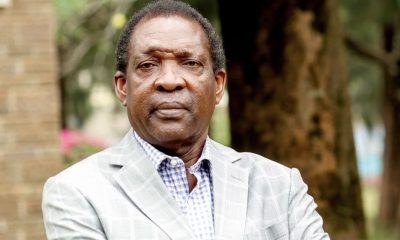By Boniface Mwangi
The mysterious killing of National Hospital Insurance Fund (NHIF) employee, Nancy Waithera, who was taken out by an alleged sniper as she walked along Kaunda Street in Nairobi on February 17, 2023, sent chills across the country and shone the spotlight on the elimination of witnesses in Kenya.
There are reports that Waithera was targeted because she was a whistleblower in a Ksh 1.1 billion scandal, where NHIF CEO, Geoffrey Mwangi, had initially been suspended but returned after he was cleared by the court.
The world was aghast after Kenya’s security forces indicted themselves after Pakistani journalist, Arshad Sharif, who had fled from his country after implicating senior government officials in corruption, was killed shortly after arriving in the country. He was shot dead on November 23, 2022, along a remote road in Magadi.
At first, Kenya Police officials explained that the journalist had been shot following an exchange of fire. The vehicle he was traveling in had been reported to the police in connection with an abduction.
Things got murkier after autopsy reports indicated that the journalist had been shot at close range by somebody who could have been inside the car.
Another killing that sent shockwaves in the conservation world was that of Joannah Stutchbury, on July 15, 2021. The 67-year-old Stutchbury was shot six times outside her Kiambu home as she got out of her car to clear the driveway, which had been blocked by tree branches. At the time, the Director of Criminal Investigations (DCI), George Kinoti, said preliminary investigations indicated that Stutchbury might have been killed for her resistance to the encroachment and illegal construction of a road on LR. No 21179 F/R. NO.284/108. Pathologists concluded that she died of multiple gunshot injuries, fired from a low-velocity firearm at close range.
Earlier in March of the same year, the body of a senior officer with the National Land Commission (NLC), Jennifer Itumbi Wambua, was discovered in a field in Ngong after she had been reported missing on March 12. Wambua was a key witness in a case where a vocal MP and a former top bureaucrat were charged with conspiring to defraud the government of Ksh 122.3 million.
The discovery rekindled the memories of the mysterious death of Sergeant Kipyegon Kenei, who worked at Deputy President William Ruto’s office and was reputed to be very close to him. Kenei was reported missing after he failed to show up at the DCI Headquarters to record a statement that would have impacted senior government officers, who had been using Harambee House Annex to conduct shady deals.
Kenei was a potential witness in a case where some influential people used Ruto’s office to defraud foreign investors of billions of shillings in a fake military tender.
Had 21-year-old Maryanne Wairimu Ngumbu, popularly known as Carol, not come to Nairobi on July 29, 2017, perhaps she would have lived to tell the world why Independent Electoral and Boundaries Commission (IEBC) ICT Manager, Chris Msando, was killed. But as fate would have it, she joined the man she had been dating for close to one year and unwittingly signed her death warrant. Her body and that of her lover were found dead at a forest in Kikuyu, Kiambu County. The police have never disclosed who tortured the two and strangled Carol, who witnessed what she was not supposed to and had to be eliminated.
Carol may not have witnessed as much as Chief Inspector Zebedeo Maina. As the head of Kwekwe and Eagle police squads, he had been implicated in the deaths of scores of adherents of the outlawed Mungiki sect, between 2008 and 2010.
At his prime, he had the power of life and death. He was shot in the head in Kitui Town where he was allegedly pursuing kidnappers together with other detectives. Two of Maina’s drivers died in suspicious circumstances too. His official driver, Bernard Kiriinya, confessed he had witnessed the killing of 58 people in one year, while working as a driver for the death squad.
Kiriinya too ended up as a statistic in 2008, after he was shot outside Sarit Center by fellow Kwekwe squad members for revealing their dirty jobs. He had deserted the group and shared information with the Kenya National Commission on Human Rights (KNCHR), who placed him under witness protection.
Police reports indicated that Kyule Kisiloki shot himself in the head at his Dadaab workstation, where he had been deployed as the director of criminal investigations. Another officer, Sergeant Gitahi, was ‘accidentally’ shot by a colleague in an operation against Mungiki in Banana Town. John Kariuki, Reche Nyagah (head of CID Mombasa), and another senior officer, Richard Katola, were poisoned as they suddenly developed liver complications leading to their deaths.
George Muchai, Kabete member of parliament was executed in a gangland-style attack by masked men with assault rifles. Mr Muchai, his two police bodyguards, and his driver were killed in February 2015. The MP had claimed his life was in danger after he threatened to take top COTU leaders to court over corruption and massive offshore accounts worth billions of shillings.
Although not a gangster, James Mania Karanja was destined to die. There was a hitman on the loose determined to kill him before he exposed the rot at Nakumatt Supermarket. On the fateful day on May 7, 2015, Karanja was shot more than three times by a gunman, a police officer who had received a down payment of Ksh 80,000 for the job. After his killing, threatening emails were sent to other Nakumatt senior officials warning them of death should they carry on with investigations into the alleged fraud.
When Kenya Revenue Authority Commissioner, Joseph Cheptarus, was assigned to investigate the mystery surrounding the disappearance of 2.5 tons of gold from the Democratic Republic of Congo, he had no idea what awaited him.
But this all became clear in April 2011 when death came calling. Cheptarus was working on a report on his findings over a gold smuggling racket, in which approximately 2.5 tons of the precious mineral had been stolen in the Democratic Republic of Congo and smuggled abroad through Kenya.
Cheptarus, who was based at the Business Intelligence section at KRA with his main duty being to investigate tax frauds, was shot dead at his gate in Nairobi’s South C estate.
This sounds familiar to what had earlier befallen Erastus Chimorei, a GSU officer who had been executed by the police at his home in Kitale on February 19, 2005. At the time, Chimorei was the custodian of a large cache of cocaine. He had the key to the store where police were storing cocaine worth Ksh 6.4 billion, which they had recovered from a private villa in Malindi.
On that day, about 50 police officers pounced at about 10 a.m., when he was negotiating with a neighbor, Abubakar Ndiema, to purchase his bull. They said they had come to recover firearms in Chemorei’s possession. After the shooting, Ndiema was ordered to carry the body to a police Land Rover and told to lie on top of it. Ndiema swore in an affidavit that the police forced him, at gunpoint, to eat Chemorei’s brain.
Ndiema and Chemorei’s widow were arrested and charged with robbery with violence but the case was withdrawn in October 2006 by the Director of Public Prosecutions. An inquest at an Eldoret magistrate’s court in 2011, concluded that Chemorei was executed by police officers in broad daylight without any reasonable excuse.
Although he was only 27 and worked as a hawker, Fredrick Musyimi died a painful death at Mwingi Level Four Hospital. The first attempt on his life was at Ukasi in Kitui after a group of police officers abducted and shot him. He was targeted because police believed he was linked to the hacking to death of a police officer’s child in Kitui. He was picked by four men claiming to be police officers, who bundled him into a white car and drove to Ukasi, along the Mwingi-Garissa highway, where they shot him several times.
Musyimi survived and was rescued by police officers from Ukasi Police Station, and taken to Mwingi Level Four Hospital where he was later killed on August 19. The killers also tried to kill his sister, Sharlyne Malia, who was with him when he was fatally shot by the killers. When she reported to the then police spokesperson, Charles Owino, she was referred to the Independent Police Oversight Authority (IPOA) who, in turn, told her to wait three days for assistance.
This list isn’t exhaustive, and we have witnesses and whistleblowers whose lives are still in danger because of what they know, and they are only alive because they have promised to never testify or go public with what they know. Whistleblowers get victimized, exposed, and abandoned at grave risk for telling the truth. If the government does not protect whistleblowers, the fight against grand corruption will fail.
Kenya Insights allows guest blogging, if you want to be published on Kenya’s most authoritative and accurate blog, have an expose, news TIPS, story angles, human interest stories, drop us an email on [email protected] or via Telegram

 Business5 days ago
Business5 days ago
 Business5 days ago
Business5 days ago
 Business2 weeks ago
Business2 weeks ago
 Politics1 week ago
Politics1 week ago
 News2 days ago
News2 days ago
 Investigations4 days ago
Investigations4 days ago
 Business2 weeks ago
Business2 weeks ago
 Investigations6 days ago
Investigations6 days ago

















